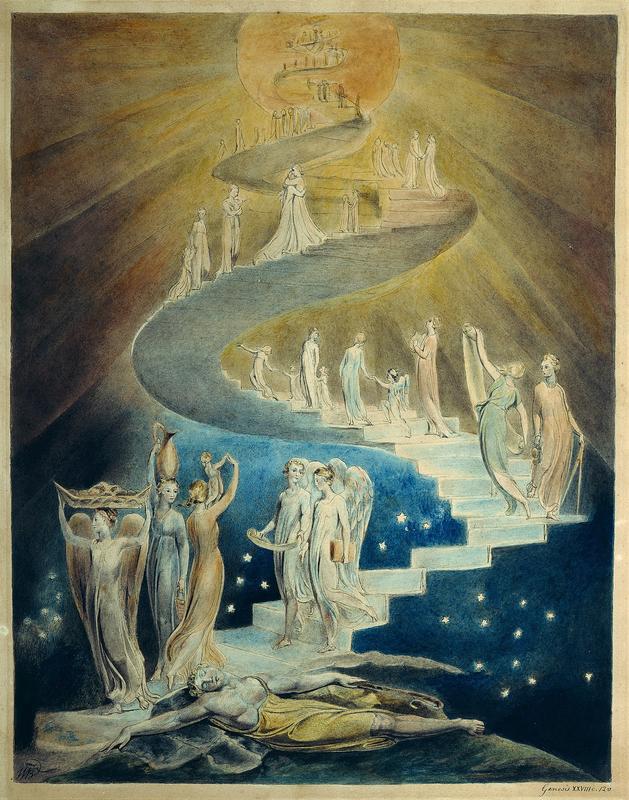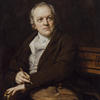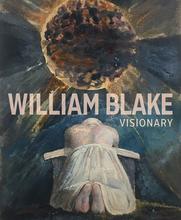More about Jacob's Ladder
- All
- Info
- Shop

Contributor
The 18th and 19th-century poet and artist William Blake's Jacob's Ladder represents a fundamental part of his esoteric investigations, and can give researchers a clue as to his interest in the hidden aspects of scriptural study.
Blake's influence extends to Sigmund Freud, Bob Dylan, Jim Morrison, and other major figures of the 20th century. Blake owes some of his enduring and profound success to the mystical style prevalent in his paintings and poetry. Whereas depiction of the scenes of the Greek New Testament were obligatory among most European artists of his time, Blake focused an unusual amount of energy on stories from the Torah, the original Hebrew texts later translated by Greeks and Europeans to form the foundation of the King James Version of the Bible. Of these stories, the depiction of Jacob's Ladder, סולם יעקב, sulam yaakov, is one of the least understood in Christian sources, because it refers to an inner dimension of Torah study, available exclusively in Hebrew, especially in Blake's era, which describes four fundamental levels of reality and of consciousness, through which Jacob ascended.
Although there is considerable debate regarding Blake's relationship to both Judaism and Kabbalah, the received tradition of understanding the hidden interpretations of the Torah, it is certain that Blake, who drew a later self-portrait with a menorah on his forehead, was strongly interested in Judaism as the theological ancestor of his own Christian faith, although he was also capable of repeating slurs against Jews.
For Blake, Jacob's Ladder as described in the Torah was a spiral staircase, a vortex leading to heaven. The image and the trope of the vortex was so important to Blake that he added it to a later illustration of the writings of Dante. Blake's "illustration for heaven [as depicted in Dante] shows a stairway not mentioned in Dante's text but clearly intended for ascension into the upper world." The Dante illustration enlarges the scale of the staircase, but the "ascending figures, the stars, and the upward spiral are similar" to this painting.
Sources
- Corrigan, John Michael. American Metempsychosis: Emerson, Whitman, and the New Poetry. New York: Fordham University Press, 2012.
- George, Diana Hume. Blake and Freud. Ithaca: Cornell University Press, 1980.
- Hopkins, Jerry. The Lizard King: The Essential Jim Morrison. Medford, NJ: Plexus, 2014.
- Jacobson, Rabbi Y.Y. "Jacob's Ladder." Kabbalah Online, https://www.chabad.org/kabbalah/article_cdo/aid/658156/jewish/Jacobs-La…
- McClure, Michael. "Bob Dylan--The Poet's Poet." Rolling Stone, Mar. 14, 1974, https://www.rollingstone.com/music/music-news/bob-dylan-the-poets-poet-….
- Patrides, C.A. Premises and Motifs in Renaissance Thought and Literature. Princeton: Princeton University Press, 2014.
- Pyle, Eric. William Blake's Illustrations for Dante's Divine Comedy: A Study of the Engravings, Pencil Sketches and Watercolors. Jefferson, NC: McFarland & Co., 2016.
- Spector, Sheila. "Kabbalistic Sources—Blake’s and His Critics’." Blake: An Illustrated Quarterly 17, no. 3 (1983-84): 84-101.
- Schuchard, M.K. "William Blake and the Jewish Swedenborgians." In The Jews and British Romanticism, edited by S.A. Spector, 61-86. New York: Palgrave Macmillan, 2005.












